
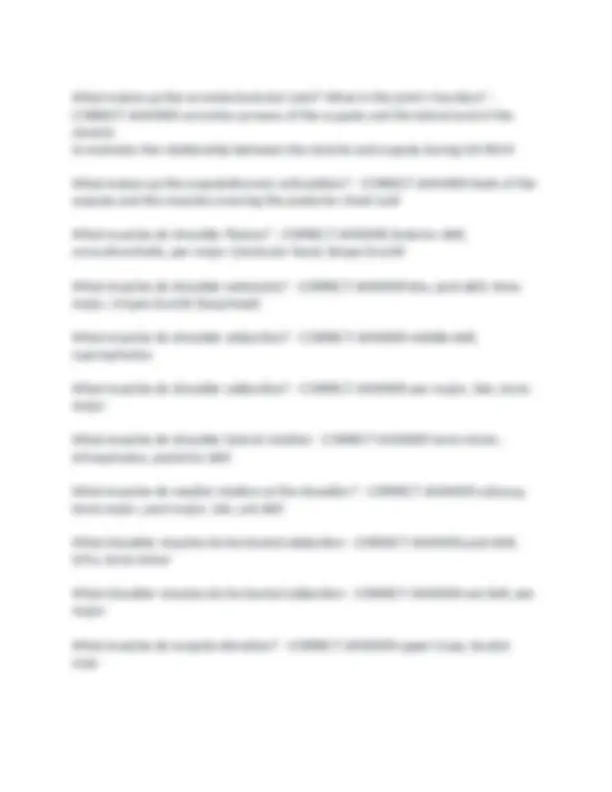
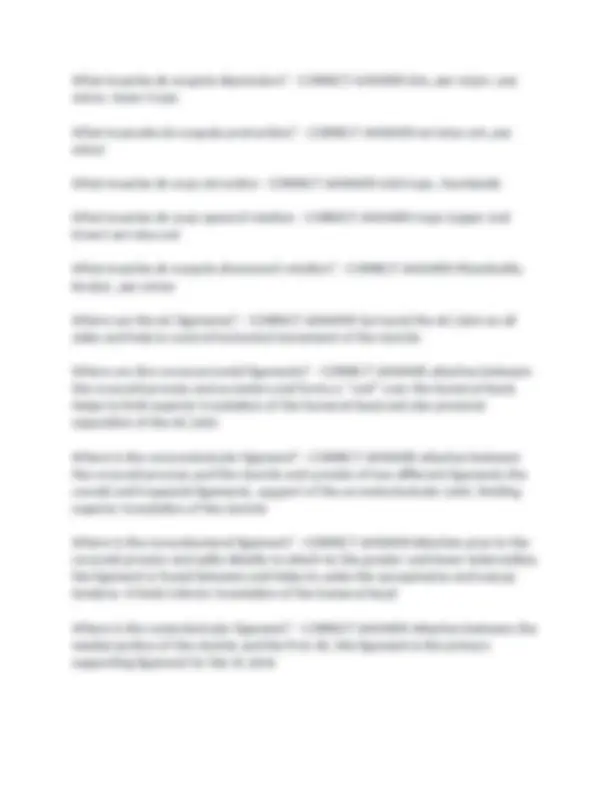
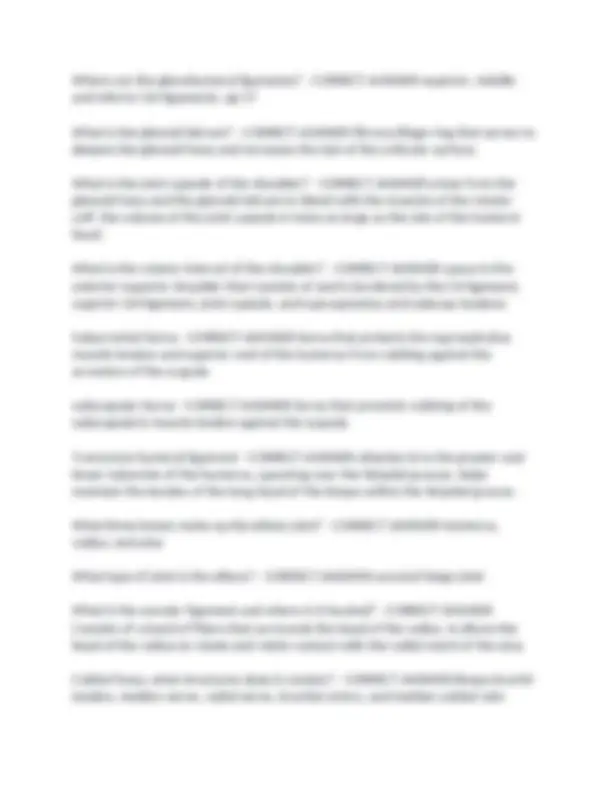
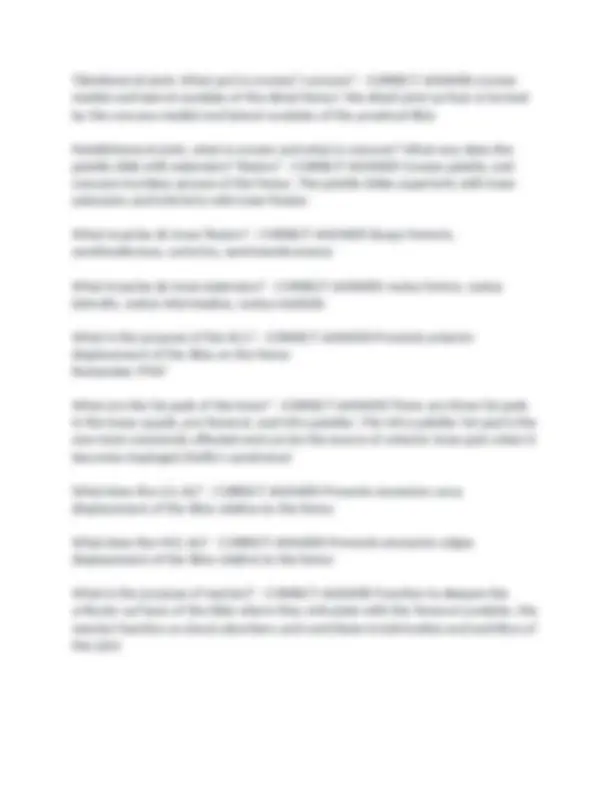
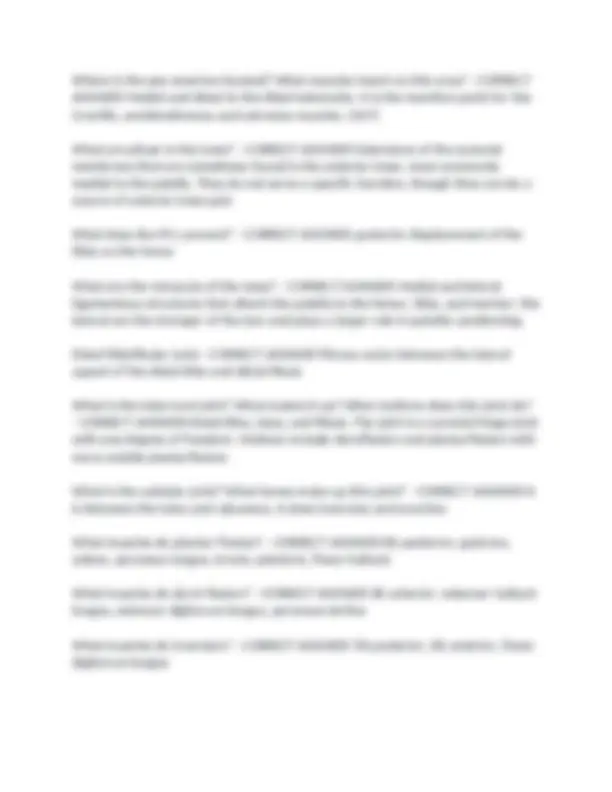
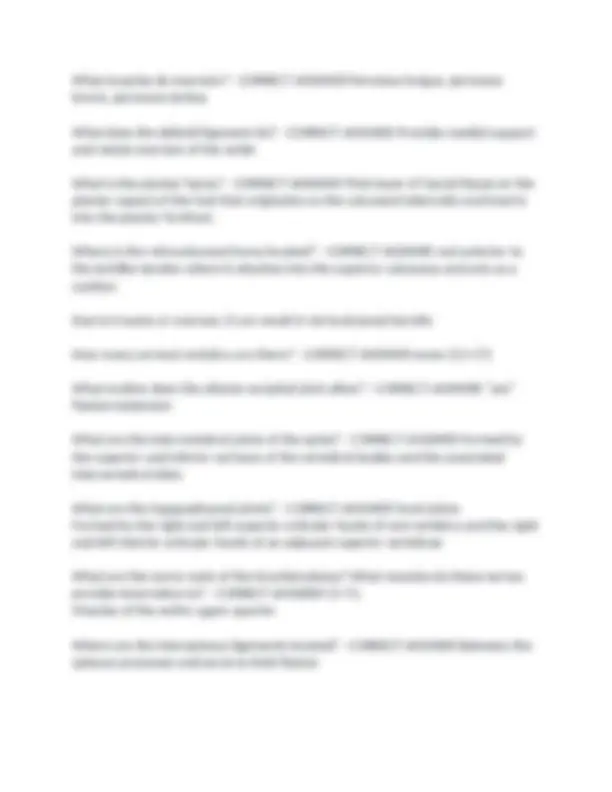
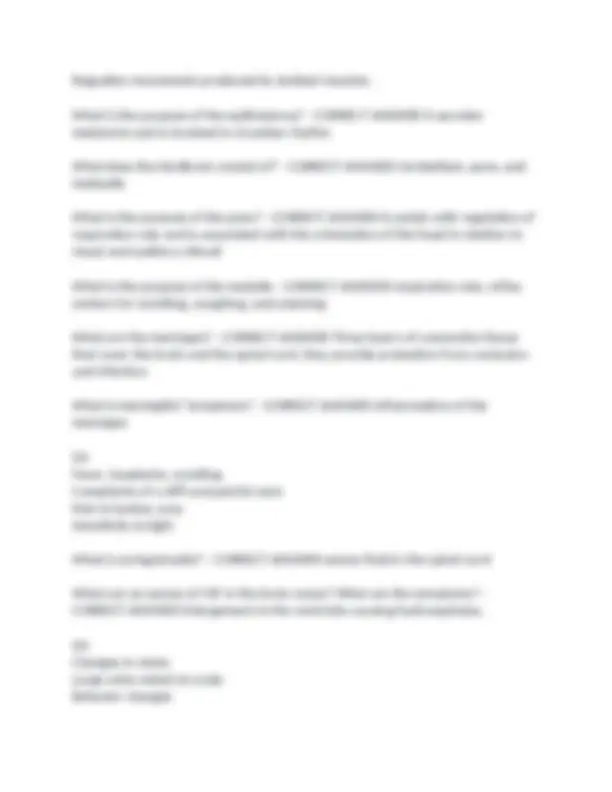
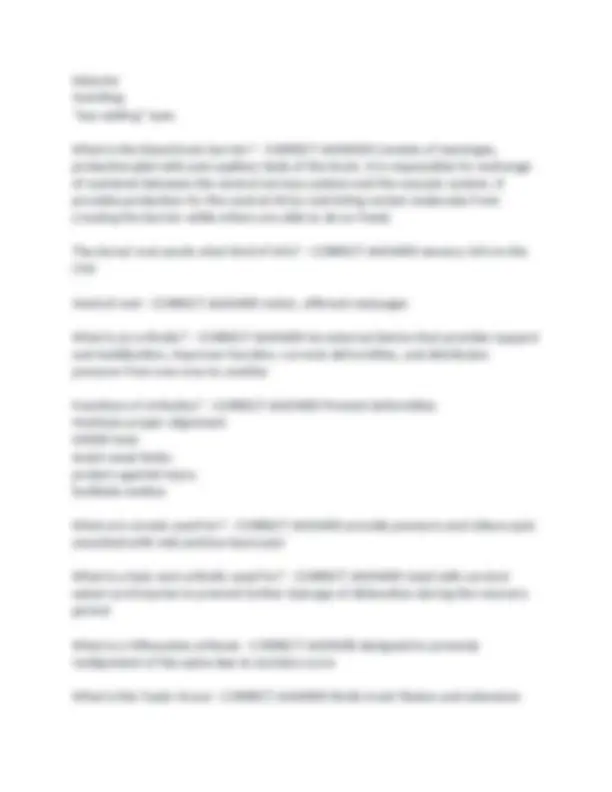
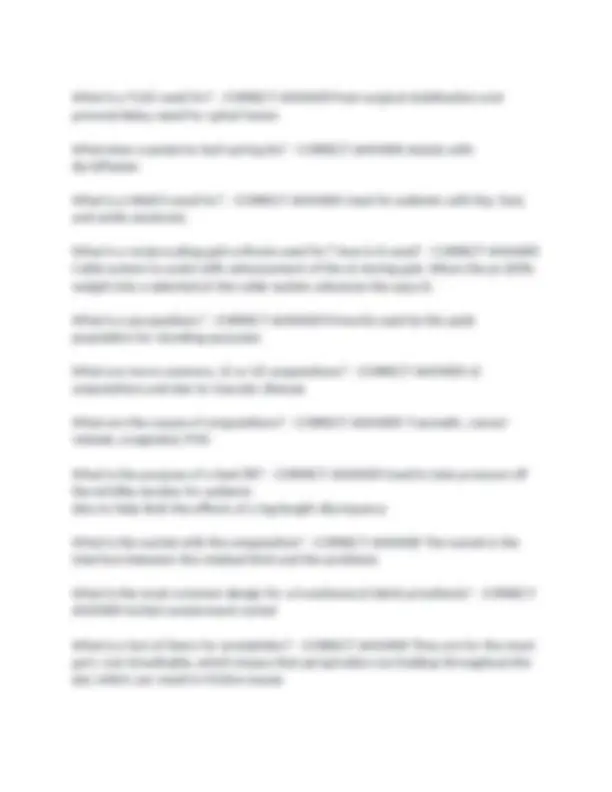
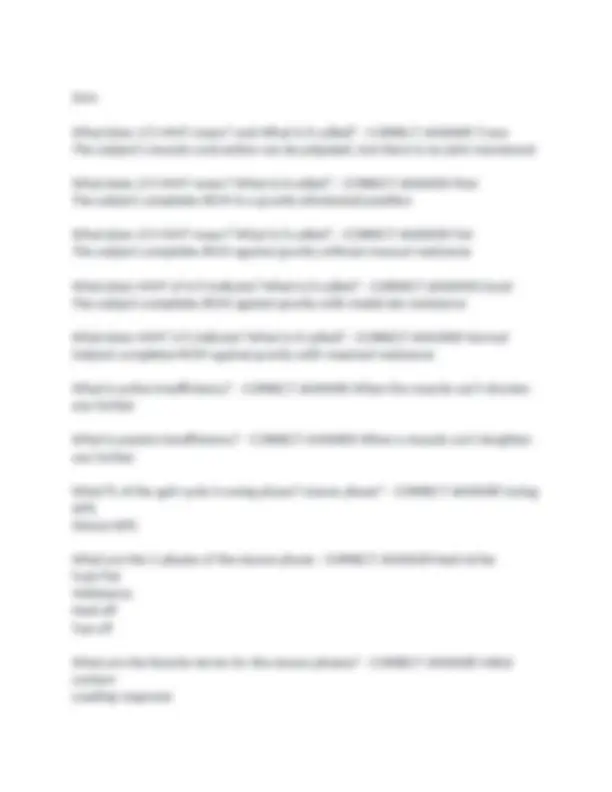
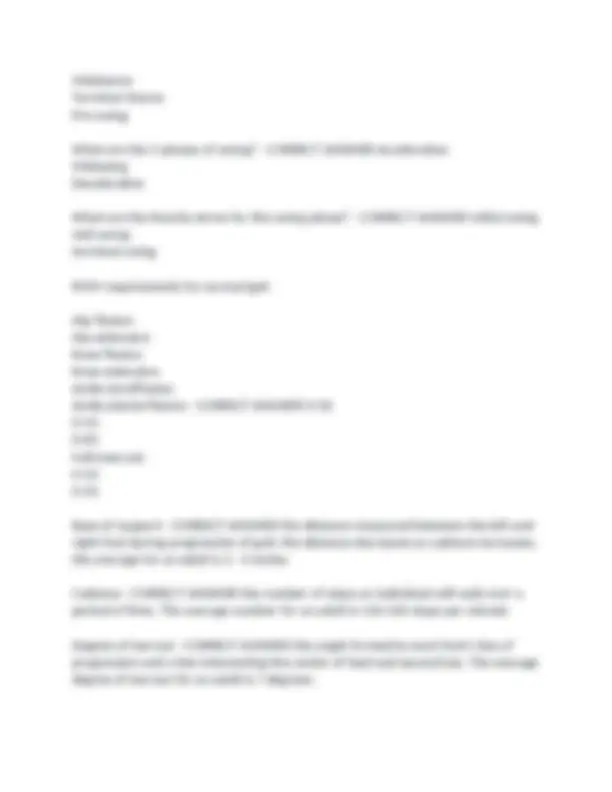
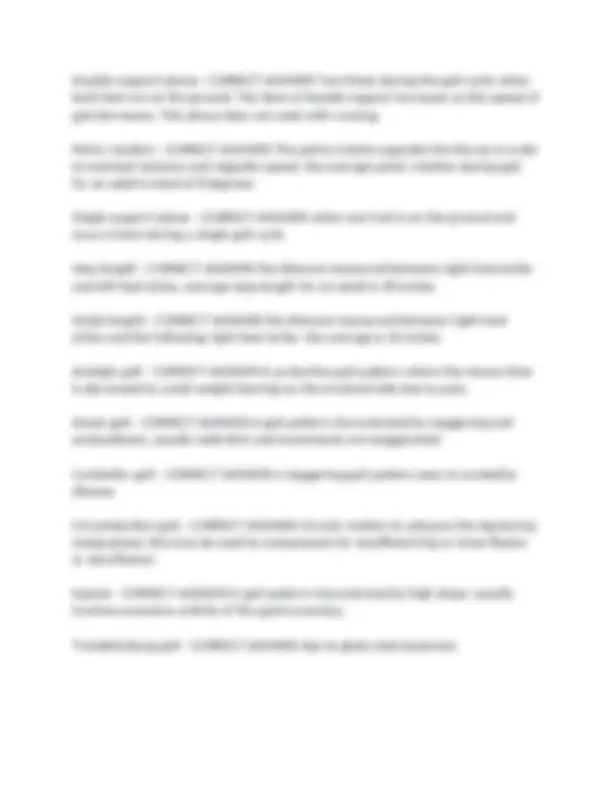


Study with the several resources on Docsity

Earn points by helping other students or get them with a premium plan


Prepare for your exams
Study with the several resources on Docsity

Earn points to download
Earn points by helping other students or get them with a premium plan
Community
Ask the community for help and clear up your study doubts
Discover the best universities in your country according to Docsity users
Free resources
Download our free guides on studying techniques, anxiety management strategies, and thesis advice from Docsity tutors
A comprehensive set of 199 questions and verified answers covering various aspects of the npte-pta exam. It covers topics such as energy systems, anatomical planes, types of levers, joint structures, muscle actions, and ligament locations. A valuable resource for students preparing for the npte-pta exam, offering a structured approach to reviewing key concepts and testing their knowledge.
Typology: Exams
1 / 20

This page cannot be seen from the preview
Don't miss anything!













What energy system is used for APT production during high intensity, short duration exercises (sprinting 100 m)? - CORRECT ANSWER ATP-PC system How long does the ATP-PC system provide energy for muscle contraction? - CORRECT ANSWER 15 seconds This energy system is a major supplier of APT during high intensity, short duration activities such as sprinting 400 or 800 m? - CORRECT ANSWER Anaerobic Glycolytic system What forms with the anaerobic glycolytic system? - CORRECT ANSWER Lactic acid How long is the anaerobic glycolytic system last? - CORRECT ANSWER 30- seconds of muscle contraction What system is used predominantly during low-intensity long duration exercise (such as running a marathon)? - CORRECT ANSWER Aerobic system How long will the Aerobic system provide energy for? - CORRECT ANSWER as long as there are nutrients to utilize How does the frontal plane divide the body? - CORRECT ANSWER into anterior and posterior sections How does the sagittal plane divide the body? - CORRECT ANSWER into right and left sections How does the transverse plan divide the body? - CORRECT ANSWER into upper and lower sections What is a class 1 lever? - CORRECT ANSWER axis of rotation is between the effort (force) and resistance (load)
What is a class 2 lever? - CORRECT ANSWER resistance (load) is between the axis of rotation (fulcrum) and the effort (force); effort arm is always longer than the resistance arm wheelbarrow. What is a class 3 lever? - CORRECT ANSWER the effort (force) is between the axis of rotation (fulcrum) and the resistance (load). Permit large movements at rapid speeds and are the MC type of lever in the body. ex: shoulder abduction w/ weight at the wrist, elbow flexion What is a fibrous joint? - CORRECT ANSWER composed of bones that are united by fibrous tissue and are non-synovial. movement is minimal to non What is a cartilaginous joint? - CORRECT ANSWER Have hyaline or fibrocartilage that connects one bone to another. they are slightly moveable joints what are Synovial joints - CORRECT ANSWER Provide free movement between the bones they join What is the muscle spindle? - CORRECT ANSWER within the belly of muscles. sends information about muscle length and/or the rate of change of its length. Important in the control of posture. What is the function of the Golgi Tendon Organ? - CORRECT ANSWER Sensing muscle tension at the Musculotendinous insertion What part of the glenohumeral joint is convex? concave? what kind of joint is it? - CORRECT ANSWER convex head of the humerus and concave glenoid fossa of the scapula ball and socket synovial joint unstable joint What forms the sternoclavicular joint? - CORRECT ANSWER medial end of the clavicle and the manubrium of the sternum
What muscles do scapula depression? - CORRECT ANSWER lats, pec major, pec minor, lower traps What muscules do scapula protraction? - CORRECT ANSWER serratus ant, pec minor What muscles do scap retraction - CORRECT ANSWER mid traps, rhomboids What muscles do scap upward rotation - CORRECT ANSWER traps (upper and lower) serratus ant What muscles do scapula downward rotation? - CORRECT ANSWER Rhomboids, levator, pec minor Where are the AC ligaments? - CORRECT ANSWER Surround the AC joint on all sides and help to control horizontal movement of the clavicle Where are the coracoacromial ligaments? - CORRECT ANSWER attaches between the coracoid process and acromion and forms a "roof" over the humeral head. Helps to limit superior translation of the humeral head and also prevents separation of the AC joint Where is the coracoclavicular ligament? - CORRECT ANSWER attaches between the coracoid process and the clavicle and consists of two different ligaments the conoid and trapezoid ligaments. support of the acromioclavicular joint, limiting superior translation of the clavicle Where is the coracohumeral ligament? - CORRECT ANSWER Attaches prox to the coracoid process and splits distally to attach to the greater and lesser tuberosities. the ligament is found between and helps to unite the spraspinatus and suscap tendons. it limits inferior translation of the humeral head Where is the costoclavicular ligament? - CORRECT ANSWER Attaches between the medial portion of the clavicle and the first rib. this ligament is the primary supporting ligament for the SC joint
Where are the glenohumeral ligaments? - CORRECT ANSWER superior, middle and inferior GH ligaments. pg 57 What is the glenoid labrum? - CORRECT ANSWER fibrocartilage ring that serves to deepen the glenoid fossa and increases the size of the articular surface. What is the joint capsule of the shoulder? - CORRECT ANSWER arises from the glenoid fossa and the glenoid labrum to blend with the muscles of the rotator cuff. the volume of the joint capsule is twice as large as the size of the humeral head. What is the rotator interval of the shoulder? - CORRECT ANSWER space in the anterior-superior shoulder that consists of and is bordered by the CH ligament, superior GH ligament, joint capsule, and supraspinatus and subscap tendons Subacromial bursa - CORRECT ANSWER bursa that protects the supraspinatus muscle tendon and superior end of the humerus from rubbing against the acromion of the scapula subscapular bursa - CORRECT ANSWER bursa that prevents rubbing of the subscapularis muscle tendon against the scapula Transverse humeral ligament - CORRECT ANSWER attaches b/w the greater and lesser tubercles of the humerus, spanning over the bicipital groove. helps maintain the tendon of the long head of the biceps within the bicipital groove. What three bones make up the elbow joint? - CORRECT ANSWER Humerus, radius, and ulna What type of joint is the elbow? - CORRECT ANSWER synovial hinge joint What is the annular ligament and where is it located? - CORRECT ANSWER Consists of a band of fibers that surrounds the head of the radius. It allows the head of the radius to rotate and retain contact with the radial notch of the ulna Cubital fossa, what structures does it contain? - CORRECT ANSWER Biceps brachii tendon, median nerve, radial nerve, brachial artery, and median cubital vein
compression of the nerve in this location may result in ulnar tunnel syndrome What is the proximal joint surface of the iliofemoral or hip joint? - CORRECT ANSWER acetabulum Which way is the acetabulum oriented?? - CORRECT ANSWER laterally, inferiorly and anterior What is the distal joint surface of the hip joint? - CORRECT ANSWER Convex head of the femur What muscles do hip flexion? - CORRECT ANSWER iliopsoas, sartorius, rectus, and pectineus Which muscules do hip extension? - CORRECT ANSWER Glutes and hamstrings What muscules do hip abduction? - CORRECT ANSWER glute med, gluet min, piriformis, obturator internus, TFL What muscules do hip adduction - CORRECT ANSWER adductors Which hip muscules do medial/internal rotation? - CORRECT ANSWER TFL, glute med, glute min, pectineus, adductor longus Which hip muscules do lateral/external rotation? - CORRECT ANSWER glute max, obturator externus, obtrator internus, piriformis, sartorius What kind of joint is the knee? What three bones make up the knee joint? - CORRECT ANSWER Synovial hinge joint. Femur, tibia, and patella What are the two primary articulations of the knee joint? - CORRECT ANSWER Tibiofemoral and patellofemoral What does the knee hinge joint consist of? What two major bones? - CORRECT ANSWER The tibia and the femur with 2 degrees of freedom
Tibiofemoral joint. What part is convex? concave? - CORRECT ANSWER convex medial and lateral condyles of the distal femur/ the distal joint surface is formed by the concave medial and lateral condyles of the proximal tibia Patellofemoral joint, what is convex and what is concave? What way does the patella slide with extension? flexion? - CORRECT ANSWER Convex patella, and concave trochlear groove of the femur. The patella slides superiorly with knee extension and inferiorly with knee flexion What muscles do knee flexion? - CORRECT ANSWER biceps femoris, semitendinosus, sartorius, semimembranosus What muscles do knee extension? - CORRECT ANSWER rectus femris, vastus lateralis, vastus intermedius, vastus medialis What is the purpose of the ACL? - CORRECT ANSWER Prevents anterior displacement of the tibia on the femur Remember PFAT What are the fat pads of the knee? - CORRECT ANSWER There are three fat pads in the knee: quads, pre femoral, and infra patellar. The infra patellar fat pad is the one most commonly affected and can be the source of anterior knee pain when it becomes impinged (Hoffa's syndrome) What does the LCL do? - CORRECT ANSWER Prevents excessive varus displacement of the tibia relative to the femur What does the MCL do? - CORRECT ANSWER Prevents excessive valgus displacement of the tibia relative to the femur What is the purpose of menisci? - CORRECT ANSWER Function to deepen the articular surfaces of the tibia where they articulate with the femoral condyles. the menisci function as shock absorbers and contribute to lubrication and nutrition of the joint
What muscles do eversion? - CORRECT ANSWER Peroneus longus, peroneus brevis, peroneus tertius What does the deltoid ligament do? - CORRECT ANSWER Provides medial support and resists eversion of the ankle What is the plantar fascia? - CORRECT ANSWER Thick layer of fascial tissue on the plantar aspect of the foot that originates on the calcaneal tuberosity and inserts into the plantar forefoot. Where is the retrocalcaneal bursa located? - CORRECT ANSWER Just anterior to the Achilles tendon where it attaches into the superior calcaneus and acts as a cushion Due to trauma or overuse, it can result it retrocalcaneal bursitis How many cervical vertebra are there? - CORRECT ANSWER seven (C1-C7) What motion does the atlanto-occipital joint allow? - CORRECT ANSWER "yes" flexion/extension What are the intervertebral joints of the spine? - CORRECT ANSWER Formed by the superior and inferior surfaces of the vertebral bodies and the associated intervertebral disks What are the Zygapophyseal joints? - CORRECT ANSWER facet joints Formed by the right and left superior articular facets of one vertebra and the right and left interior articular facets of an adjacent superior vertebrae What are the nerve roots of the brachial plexus? What muscles do these nerves provide innervation to? - CORRECT ANSWER C5-T1. Muscles of the entire upper quarter Where are the interspinous ligaments located? - CORRECT ANSWER Between the spinous processes and serve to limit flexion
What is the purpose of the intervertebral foramina? - CORRECT ANSWER Spinal nerves and blood vessels exit the spinal canal via the foramina. The size of the IF increases with flexion and decreases with extension What is the purpose of the ligamentum flavum? - CORRECT ANSWER It connects the lamina of one vertebra to the lamina of the vertebra above it. It limits flexion Ligamentum nuchae what motion does it restrict? - CORRECT ANSWER flexion What muscles do cervical flexion? - CORRECT ANSWER SCM, scalenus What muscles do cervical extension? - CORRECT ANSWER Splenius cervicis, iliocostalis, longisssimums What muscles do cervical rotation and lateral bending? - CORRECT ANSWER SCM, scalenus, longissimus, iliocostalis, levator The thorasic spine consists of how many vertebra? - CORRECT ANSWER 12 How many of the vertebrae have articular facets on each transverse process where the ribs articulate? - CORRECT ANSWER the first 10 thoracis vertebrae do What muscles do trunk flexion? - CORRECT ANSWER Rectus, internal oblique, external oblique What muscles do trunk extension? - CORRECT ANSWER Erector spinae, quadratus lumborum What muscles do trunk rotation and lateral bending? - CORRECT ANSWER psoas major, quad lumborum, external oblique, internal oblique, longissimus, iliocostalis What is considered the cerebrum and what divides it? - CORRECT ANSWER It is the part of the brain that encompasses the major portion of the brain It is divided in two by the corpus collosum What is the outer surface of the cerebrum termed? Inner portion? - CORRECT ANSWER outer: gray matter
Regualtes movements produced by skeletal muscles. What is the purpose of the epithalamus? - CORRECT ANSWER It secretes melatonin and is involved in circadian rhythm What does the hindbrain consist of? - CORRECT ANSWER Cerebellum, pons, and medualla What is the purpose of the pons? - CORRECT ANSWER It assists with regulation of respiration rate and is associated with the orientation of the head in relation to visual and auditory stimuli What is the purpose of the medulla - CORRECT ANSWER respiration rate, reflex centers for vomiting, coughing, and sneezing What are the meninges? - CORRECT ANSWER Three layers of connective tissue that cover the brain and the spinal cord, they provide protection from contusion and infection What is meningitis? Symptoms? - CORRECT ANSWER inflammation of the meninges SX: Fever, headache, vomiting Complaints of a stiff and painful neck Pain in lumbar area Sensitivity to light What is syringomyelia? - CORRECT ANSWER excess fluid in the spinal cord What can an excess of CSF in the brain cause? What are the symptoms? - CORRECT ANSWER Enlargement in the ventricles causing hydrocephalus. SX: Changes in vision Large veins noted on scalp Behavior changes
Seizures Vomiting "Sun setting" eyes What is the blood brain barrier? - CORRECT ANSWER Consists of meninges, protective glial cells and capillary beds of the brain. It is responsible for exchange of nutrients between the central nervous system and the vascular system. It provides protection for the central NS by restricting certain molecules from crossing the barrier while others are able to do so freely The dorsal root sends what kind of info? - CORRECT ANSWER sensory info to the CNS Ventral root - CORRECT ANSWER motor, efferent messages What is an orthotic? - CORRECT ANSWER An external device that provides support and stabilization, improves function, corrects deformities, and distributes pressure from one area to another Functions of orthotics? - CORRECT ANSWER Prevent deformities Maintain proper alignment Inhibit tone Assist weak limbs protect againist injury facilitate motion What are corsets used for? - CORRECT ANSWER provide pressure and relieve pain associted with mid and low back pain What is a halo vest orthotic used for? - CORRECT ANSWER Used with cervical spinal cord injuries to prevent further damage of dislocation during the recovery period What is a Milwaukee orthosis - CORRECT ANSWER designed to promote realignment of the spine due to sociolos curve What is the Taylor brace - CORRECT ANSWER limits trunk flexion and extension
What are prosthetic socks used for? - CORRECT ANSWER to maintain a congruent and comofortable fit What is the "wear schedule" for prosthesis? - CORRECT ANSWER A general rule is to state with one hour a day of total wear time, with half the time spent ambulating. Every 30 minutes or immediately after walking, the skin should be inspected for breakdown What is the time-line for the pre-prosthetic phase of rehab?? - CORRECT ANSWER generally lasts 6 weeks How often does medicare support a new prosthesis? - CORRECT ANSWER Every 5 years What is phantom limb? - CORRECT ANSWER refers to a painless sensation where the patient feels that the limb is still present How many vertebrae make up the thorasic spine? Which ones articulate with the ribs? - CORRECT ANSWER 12 vertebrae the first ten thoracic vertebrae have articular facets on each transverse process where the ribs articulate Intervertebral joints of the thoracolumbar spine - CORRECT ANSWER formed by the superior and inferior surfaces of the vertebral bodies and associated intervertebral disks Zygapophyseal joints - CORRECT ANSWER The joints between articular processes of vertebra are termed: Anterior longitudinal ligament - CORRECT ANSWER limits extension Anterior sacroiliac ligament - CORRECT ANSWER The weakest of the sacroiliac ligaments Coccyx - CORRECT ANSWER articulates with the sacrum Four small fused vertebral bodies
Illiolumbar ligament - CORRECT ANSWER originates from the transverse processes of L4 and L5 and attaches to the medial side of the iliac crest it is often the FIRST ligament to become pain in lumbosacral decompensation Interosseous sacroiliac ligament - CORRECT ANSWER Resists anterior and inferior movements of the sacrum Interspinous ligaments - CORRECT ANSWER located between the spinous processes and serve to limit flexion and rotation of the spine What are intervertebral disks? - CORRECT ANSWER dense layer of collagen fibers and fibrocartilage called the annulus fibrosus as well as the flexible inner layer called the nucleus pulpous. Intervertebral foramina - CORRECT ANSWER spinal nerves and blood vessels exit the spinal canal via the foramina. the size increases with flexion and contralateral sidebending and decreases with extension and ipsilateral sidebending A-delta fibers transmit what kind of pain? - CORRECT ANSWER sharp, and localized C-fibers transmit what kind of pain? - CORRECT ANSWER dull, aching, and diffuse What is the visual analogue scale? - CORRECT ANSWER a tool used to assess pain intensity using a 10-15 cm line with the left anchor indicating "no pain" and the right anchor indicating "worst pain you can have" What is an end feel for MMT? - CORRECT ANSWER a type of resistance that is felt when passively moving a joint through the end range of motion What is abnormal end feel? - CORRECT ANSWER consists of any end-feel that is felt at an abnormal or inconsistent point in the ROM or in a joint that normally presents with a different end-feel What does 0/5 MMT mean? - CORRECT ANSWER the subject demonstrates no palpable muscle contraction
Midstance Terminal Stance Pre-swing What are the 3 phases of swing? - CORRECT ANSWER Acceleration Midswing Deceleration What are the Rancho terms for the swing phase? - CORRECT ANSWER Initial swing mid swing terminal swing ROM requirements for normal gait Hip flexion Hip extension Knee flexion Knee extension Ankle dorsiflexion Ankle plantarflexion - CORRECT ANSWER 0- 0- 0- Full knee ext 0- 0- Base of support - CORRECT ANSWER the distance measured between the left and right foot during progression of gait; the distance decreases as cadence increases; the average for an adult is 2 - 4 inches Cadence - CORRECT ANSWER the number of steps an individual will walk over a period of time. The average number for an adult is 110-120 steps per minute Degree of toe-out - CORRECT ANSWER the angle formed by each foot's line of progression and a line intersecting the center of heel and second toe. The average degree of toe-out for an adult is 7 degrees.
Double support phase - CORRECT ANSWER Two times during the gait cycle when both feet are on the ground. The time of double support increases as the speed of gait decreases. This phase does not exist with running Pelvic rotation - CORRECT ANSWER The pelvis rotates opposite the thorax in order to maintain balance and regualte speed. the average pelvic rotation during gait for an adult is total of 8 degrees Single support phase - CORRECT ANSWER when one foot is on the ground and occurs twice during a single gait cycle Step length - CORRECT ANSWER the distance measured between right heel strike and left heel strike. average step length for an adult is 28 inches Stride length - CORRECT ANSWER the distance measured between right heel strike and the following right heel strike. the average is 56 inches Antalgic gait - CORRECT ANSWER A protective gait pattern where the stance time is decreased to avoid weight bearing on the involved side due to pain. Ataxic gait - CORRECT ANSWER A gait pattern characterized by staggering and unsteadiness, usually wide BOS and movements are exaggerated Cerebellar gait - CORRECT ANSWER a staggering gait pattern seen in cerebellar disease Circumduction gait - CORRECT ANSWER Circular motion to advance the leg during swing phase; this may be used to compensate for insufficient hip or knee flexion or dorsiflexion Equine - CORRECT ANSWER A gait pattern characterized by high steps; usually involves excessive activity of the gastrocnemius. Trendelenburg gait - CORRECT ANSWER due to glute med weakness